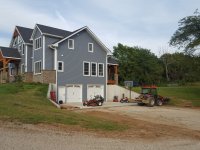For sure drill holes and drive in rebar, epoxy helps. We usally use the same size of drill bit as the rebar diameter is. You need rebar pins on both sides of any cracks, existing saw cuts or expansion joints. Then the rest of the edge can be spaced out. 12 inch to 24 inch apart for the pins, more pins is better. Put rebar in the new concrete if at all possible. Not getting into a long discussion on if rebar is needed, or if fiber mesh or wire is good enough. Nothing replaces rebar. Try to plan ahead where saw cuts will be after you pour. Put rebar on both sides of the saw cuts about 6 inches away and then fill in between as needed. Once again 12 to 24 inch or in between, more rebar is better. #3 rebar ( 3/8 inch ) is prolly ok, #4 is better and less likely to be bent in shipping and handling. Perhaps a extra rebar at the edge where you drive up on to the new drive section. Any existing saw cuts or cracks will have a tendency to continue into the new concrete at the same place. So keep that in mind when planing your saw cuts. 40 ft of concrete in general between expansion joints as a rule of thumb10 ft squares after saw cutting is usually about as far as you want to go. . Pack the base before you pour !

